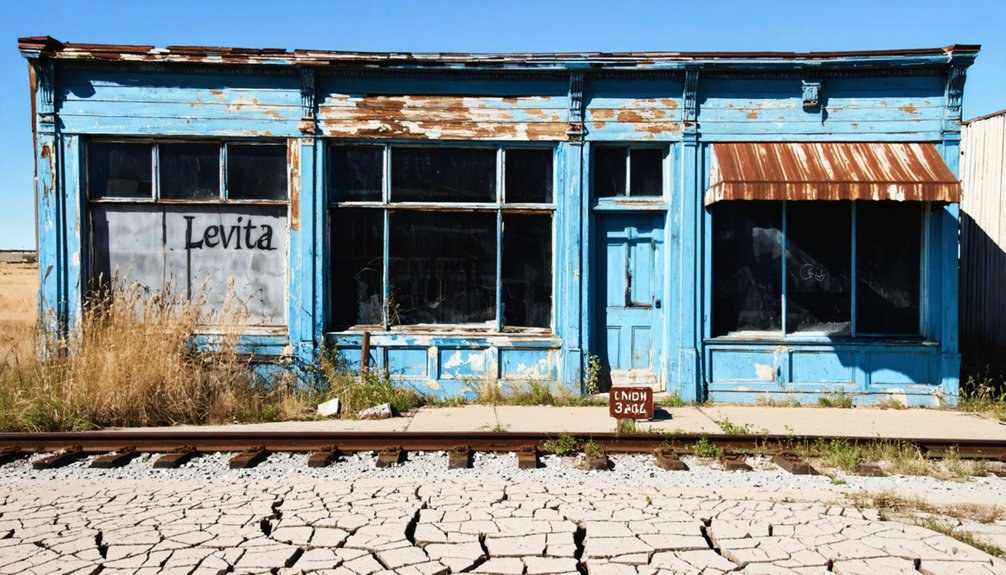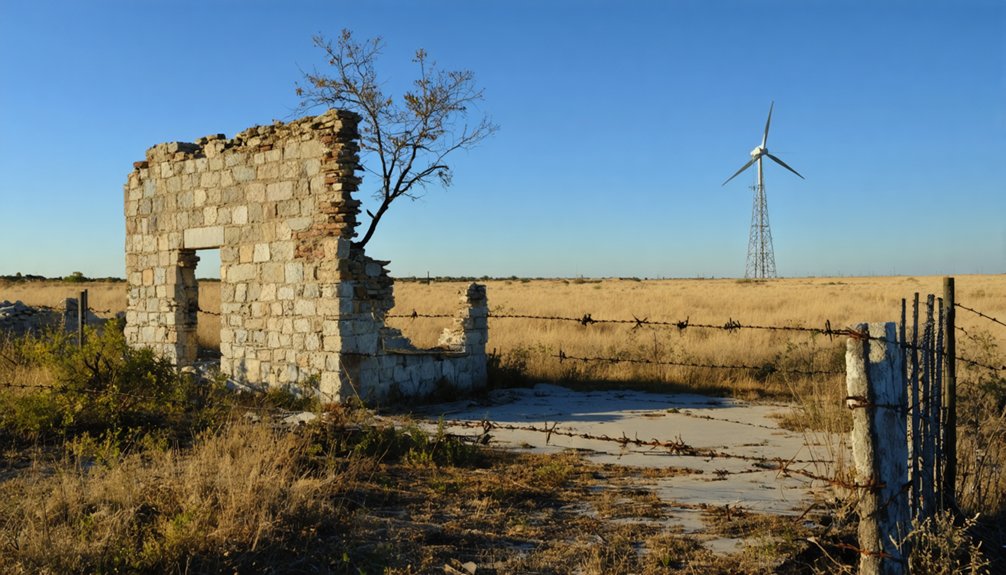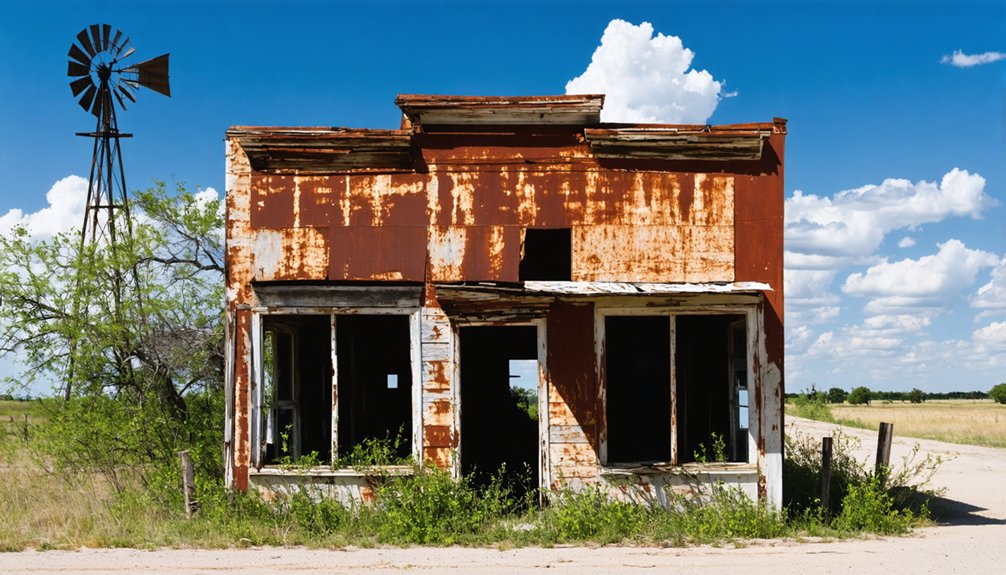You’ll find Levita nestled in Coryell County, Texas, where it once thrived as a cotton-farming powerhouse and rural medical hub. In its heyday around 1906, the town produced 58,000 bales of cotton annually and boasted three physicians serving the surrounding farmlands. Today, this ghost town stands as a memorial to rural Texas’s agricultural past, with historic ruins and abandoned structures telling a compelling story of boom-to-bust transformation. The site’s rich heritage holds countless untold tales.
Key Takeaways
- Levita was a prosperous cotton farming community in Coryell County that became a ghost town following post-war rural depopulation.
- The town served as a significant rural healthcare hub with three physicians during its peak in the early 20th century.
- Historic ruins include mining infrastructure with 600-800 foot deep shafts, adobe home foundations, and a preserved General Store structure.
- Economic decline began in the 1950s with school consolidation, leading to business closures and demographic shifts.
- Deteriorating social infrastructure and limited employment opportunities have left Levita largely abandoned, with protected historic sites remaining.
The Early Days of Cotton and Commerce
Cotton’s transformative influence on Texas began humbly in the Spanish missions of the early 18th century, where it was grown for local craftsmen, before evolving into a commercial powerhouse with Stephen F. Austin’s colony in 1821.
You’ll find that early cotton cultivation flourished between the Brazos and Colorado rivers, where large plantations relied on slave labor to drive commerce expansion.
As Native American removals opened new territories in the 1850s and 1860s, cotton production surged dramatically. By 1859, Texas farms were producing 431,645 bales annually.
You’d see the impact in places like Levita, where cotton became the economic backbone. The success of cotton production would eventually lead Lubbock to become the “Cottonest City” in the world by 1960.
The region’s initial reliance on river transport for marketing cotton southward into Mexico would soon give way to revolutionary changes, as railroads arrived to connect these agricultural communities with broader markets, transforming local farming operations into essential contributors to Texas’s agricultural dominance.
Medical Heritage: Three Doctors in a Small Town
Levita’s unique distinction as home to two resident doctors in the early 20th century marked it as a significant rural healthcare hub for Coryell County.
You’ll find these physicians served not just as medical practitioners but as integral community leaders who handled everything from farm accidents to infectious diseases.
Their presence helped sustain Levita’s population during its prime years, as access to medical care proved vital for retaining residents in rural Texas communities. Similar to the pioneer spirit shown in towns like Medicine Mound, these doctors demonstrated remarkable resilience in maintaining healthcare services despite challenging conditions. Located 11 miles from Gatesville, the town’s strategic position made it an accessible medical center for surrounding rural communities.
Rural Healthcare Hub
Despite its small size, Levita established itself as a remarkable rural healthcare hub in the late 19th century, with three physicians serving the community during its peak years.
You’ll find this achievement particularly significant given that most rural Texas towns relied solely on traveling doctors and midwives. Like other frontier communities, Levita’s healthcare system integrated traditional healers and home remedies with emerging medical practices.
The town’s clinic accessibility reflected broader changes in rural healthcare delivery, operating during a time when Texas was expanding its medical infrastructure. Following common practice of the era, these doctors likely performed bloodletting and purging as standard treatments.
While larger towns focused on building hospitals and sanatoriums, Levita maintained its essential medical services through local doctors who provided broad-spectrum care, marking the community’s commitment to serving both town residents and surrounding farm families. Similar to many rural hospitals today, Levita’s medical providers faced unique challenges serving older and underinsured patients.
Doctors’ Local Impact
The historical record reveals two dedicated physicians, not three as previously thought, who shaped Levita’s medical landscape during its prime. These doctor community leaders delivered essential healthcare while fostering social stability in this frontier settlement.
- Provided critical primary care through house calls and treatment of common rural ailments
- Served as community leaders and public health advisors, influencing local policy
- Helped attract other professionals to the area, strengthening economic development
- Managed infectious disease outbreaks and general medical emergencies
- Built trust through multiple social roles beyond their medical duties
Similar to Medicine Mound’s reliance on pioneer families, these physicians established themselves as respected pillars of the community. While physical evidence of Levita’s healthcare legacy remains scarce, oral histories and family records confirm these physicians’ crucial contribution to the town’s development.
Their presence transformed Levita into a regional healthcare hub, though documentation of their specific practices has largely faded with time. Like many Texas towns affected by economic shifts, Levita’s medical services eventually declined as population and resources dwindled.
Agricultural Roots and Local Economy
Agricultural activity formed the bedrock of Coryell County’s development, with Levita emerging as a prime example of rapid rural expansion during the mid-19th century.
You’ll find evidence of this growth in the dramatic increase of local farms, which jumped from 279 to 1,546 between 1870 and 1880. The improved farmland expanded nearly eightfold during this period, reaching 83,258 acres.
The Levita Baptist Church helped document this rich agricultural heritage through its oral history project in 2017. Tenant farming and sharecropping practices became increasingly prevalent, rising from one-third of county farms in 1880 to 58% by 1930.
The region’s agricultural focus evolved over time, starting with diverse crop farming before shifting to livestock operations. Cotton cultivation became a dominant force, with a record 58,000 bales harvested in 1906. This agricultural foundation supported a vibrant local economy in Levita, complete with banks, general stores, and essential services for the farming community.
Geographic Setting and Natural Landmarks
Located 11 miles west of Gatesville in Coryell County, Levita sits amid gently rolling plains characteristic of central Texas’s rural landscape. The region’s hot climate and sparse water sources shaped the town’s development, with early settlers relying on local wells and small creeks for survival.
Key landscape features you’ll encounter include:
- Expansive grasslands dotted with drought-resistant trees
- Agricultural fields reflecting the area’s farming heritage
- Historic cemetery marking the community’s past
- Network of accessible 2WD roads connecting to nearby settlements
- Undeveloped terrain preserving the ghost town’s authentic character
You’ll find no major rivers or distinctive geological formations near Levita, but its isolated setting and natural surroundings offer a genuine glimpse into early Texas frontier life.
Population Changes Through the Decades

While exact population figures remain scarce, historical records indicate that Levita reached its peak during the early 1900s, when it flourished as Simpsonville with two banks, multiple general stores, and resident doctors serving the community.
You’ll find that population trends began shifting dramatically by mid-century.
The 1950s marked a turning point when Oakton and Levita schools consolidated, signaling the community’s decline.
This demographic shift mirrored the broader pattern of rural depopulation across Texas during post-war industrialization.
Surviving Structures and Historic Buildings
Today’s visitors to Levita can explore an array of historic ruins that paint a vivid picture of this former mining community’s past. The surviving architecture reveals the town’s mining heritage through scattered foundations, mine shafts, and remnants of industrial equipment that once drove the local economy.
Scattered mine shafts and weathered foundations tell the story of Levita’s rich industrial heritage as a thriving mining town.
Key features of Levita’s community heritage include:
- Deep mine shafts reaching 600-800 feet, with original track areas
- Adobe home foundations from early 20th-century residents
- Standing General Store structures representing commercial life
- Mining infrastructure remains, including timber-framed entrances
- Stone ruins with protective fencing to preserve historical integrity
You’ll find most structures are now protected by no-trespassing signs, though you can still observe these remarkable remnants of Texas mining history from designated viewing areas.
Life in Modern-Day Levita

Despite its historic significance as a thriving mining town, modern-day Levita exemplifies the struggles of rural Texas communities facing severe demographic decline and economic challenges.
You’ll find a stark reality where deaths outnumber births, and younger residents consistently migrate toward metropolitan areas along Interstate 35.
Community engagement has diminished as social infrastructure crumbles. With closures of essential businesses, schools, and churches, remaining residents experience increasing isolation.
Local services continue to deteriorate while property values decline, creating a cycle of economic hardship. Those who stay face rising costs of ownership, limited employment prospects, and fragmented social networks.
Without substantial investment in infrastructure and development, Levita’s future remains uncertain, reflecting a broader pattern of rural Texas towns fighting to maintain their relevance in an increasingly urbanized state.
Frequently Asked Questions
What Native American Tribes Originally Inhabited the Levita Area?
You’ll find the area’s cultural heritage centered on Coahuiltecan peoples initially, before Lipan Apache gained tribal influence through migration, followed by Comanche dominance and periodic Tonkawa presence.
When Was the First Church Established in Levita?
While church history records aren’t definitive, you’ll find religious significance in Levita’s first church establishment likely occurred around 1854, following the county’s broader pattern of Baptist congregations forming that year.
Did Levita Ever Have a School, and When Did It Close?
You’ll find Levita education history confirms a school existed by the early 1900s when the town was thriving, but its closure date isn’t precisely documented, likely coinciding with the community’s mid-century decline.
What Caused the Fires or Disasters That Affected Levita’s Development?
You’ll find two major fire outbreaks destroyed Coryell County’s courthouse and records in 1873, with suspected arson. While these disaster impacts affected regional administration, no direct fires specifically destroyed Levita itself.
Are There Any Documented Paranormal Activities in Abandoned Levita Buildings?
You’ll find extensive ghost sightings in Levita’s abandoned structures, including EVP recordings, physical encounters with an entity called “Hal,” and haunted locations centered around the old courthouse where apparitions frequently appear.
References
- https://mix941kmxj.com/the-strange-sad-story-of-a-texas-ghost-town-youll-never-visit/
- https://texashighways.com/travel-news/four-texas-ghost-towns/
- https://www.youtube.com/watch?v=phjUE19A8HM
- https://en.wikipedia.org/wiki/List_of_ghost_towns_in_Texas
- http://www.txgenweb.org/research/landmarks/coryell.htm
- https://www.texasescapes.com/CentralTexasTownsNorth/Levita-Texas.htm
- https://www.coryellcounty.org/page/coryell.History
- https://www.ghosttowns.com/states/tx/levita.html
- https://www.texasescapes.com/Counties/Coryell-County-Texas.htm
- https://services.austintexas.gov/edims/document.cfm?id=307020



